Hey there! As a chicken fanatic myself, I totally get how crucial it is to keep our feathered friends feeling tip-top. Trust me; I’ve been down this road before, running my own little backyard farm. And believe me, no matter how savvy we think we are at spotting problems, sometimes things just take us by surprise.
So, here’s the deal – there’s a handful of common issues that pop up with chickens now and then. Nutrition/metabolic stuff is one thing; infections are another, along with creepy crawlies like parasites making themselves comfy. Then add in a dash of funky behaviors, and boom – a recipe for some worried nights tossing and turning in bed.
And because life loves to throw curveballs, eventually, every fowl owner faces the big question mark when something ain’t quite right, but they haven’t got a clue why. Bummer city, Well, luckily, yours truly has gone through plenty of these scenarios, learning from mistakes made and lessons learned, gleaned from all sorts of sources that seem trustworthy enough (plus a pinch of an instinctual gut feeling cause you can never be too careful).
So stick around as we dive into each category and learn how to protect against potential threats to our beloved cluckers, and maybe even gain some husbandry skills that make us feel like total rockstars.
Here are some of the more common chicken diseases, how to recognize them, and tips for treatment.
1. Coccidiosis
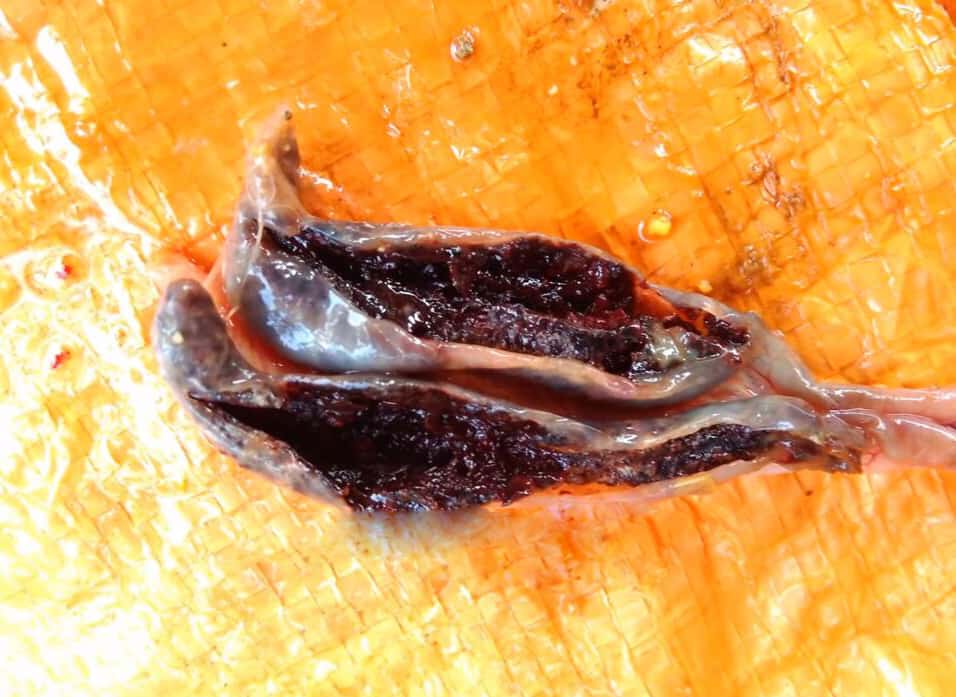
Oh no! Coccidiosis sounds like a pretty scary thing for chickens. Did you know that it’s actually one of the most common parasitic chicken diseases out there? Yep, according to Bentoli (a trusty old livestock feed company), Coccidiosis wreaks havoc on the gut lining of poor defenseless hens.
And if that wasn’t bad enough, it could make existing health problems even worse – talk about kicking poor birdies when they’re down! But hey, don’t worry too much if your flock is mostly made up of adult birds. They might still get sick from Coccidiosis, but they tend to recover quicker compared to those sweet innocent chicks who haven’t built up their immunity yet.
Contraction Of Coccidiosis
The disease is initially contracted through the consumption of a parasitical single-cell organism or oocyst that is spread via spores. “Coccidiosis starts with an oocyst or microscopic egg, that is passed through a chicken’s droppings.” The egg may lie dormant for some time before it sporulates.
A sporulated oocyst is often consumed through contaminated water. The parasite may also be picked up when a chicken scratches the ground to find worms and insects. When consumed, the oocyst will make a home in the chicken’s gut by attaching itself to the intestinal lining.
This allows the parasite to begin a lifecycle and continue to multiply. As the parasite takes over, the intestine’s healthy functions are compromised, causing a number of both visible and non-visible symptoms.
Symptoms of Coccidiosis
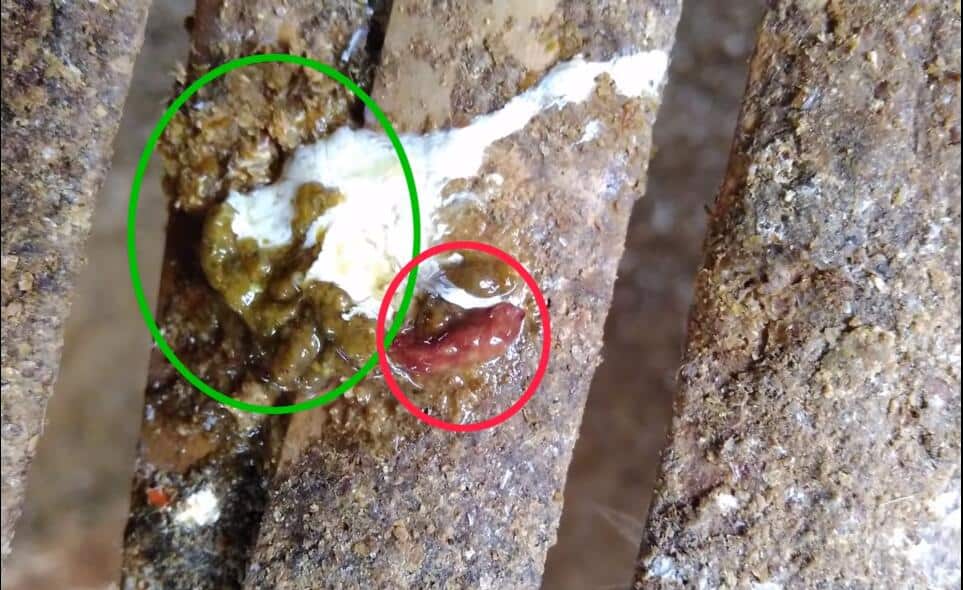
The most common symptom of this affliction is blood or mucus in chicken droppings. However, you should be aware that there are both other chicken diseases and other perfectly normal reasons why a chicken’s droppings might appear red or reddish-brown.
Other very common noticeable symptoms of Coccidiosis include loss of appetite, diarrhea, and weight loss. Weight loss will occur due to the bird no longer wanting to eat, diarrhea, and because they are not able to absorb some necessary nutrients. If you notice that your chickens have unkempt or ruffled feathers, pale combs or skin, or a general sense of fatigue or weakness, these may also be signs that Coccidiosis is present.
Treatment For Coccidiosis
Treatment for Coccidiosis can be a fairly simple matter, especially if you catch the condition early enough.
Coccidiosis is treated with the antiprotozoal Amprolium, commonly sold under the brand names Amprol and Corid. This medicine for chicken diseases can be administered through food or water. However, since Coccidiosis does cause a lack of appetite, you may need to manually administer the medicine to your chickens orally.
The good news is that, by treating your entire flock with Amprolium promptly, you might be able to control an outbreak of Coccidiosis. Under optimal conditions, it could take around a week to fully eradicate the condition.
If you are in need of more specific info, you can read our article: Coccidiosis in Chickens: How to Treat and Prevent.
2. Fowl Cholera
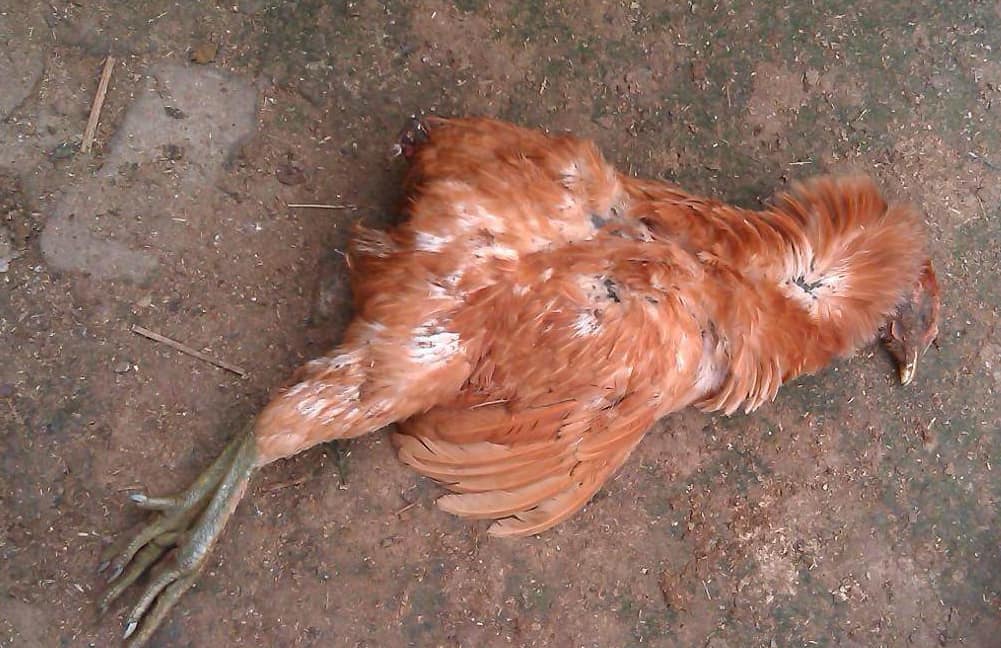
Fowl cholera is one of the more highly infectious chicken diseases that can be a risk to your birds. According to the MSU extension, this condition, also transferred through a parasite found in chicken droppings, is so easily spread because, unlike some chicken diseases, it does affect many other species of birds.
All of the following can carry and spread this disease from species to species: chickens, turkeys, pheasants, pigeons, waterfowl, and sparrows.
This disease causes infection of the respiratory system, joints, small intestine, liver, and spleen. It may also cause pneumonia-type symptoms resulting from infections in the ears and lungs.
Contraction Of Fowl Cholera
Fowl cholera is caused by the evil bacterium Pasteurella multocida, which just won’t rest until your poor birdie is down with cholera. Now, these pesky little critters can’t walk (or swim), but boy, oh boy, they make up for that by hitchhiking rides in food and water.
They sneak into our feathered friends like ninjas, and before you know it, BAM! You got yourself one unhappy, potentially very ill avian companion. If you suspect something’s wrong, don’t mess around – get them some medical help; quicker than a New York minute!
Trust me; this is no time to play doctor – life hangs in the balance here, folks! So take heed: keep watch over those fine feathers and make sure they stay healthy. You don’t want to know the “Or Else!”
The disease can also be spread through the remains of other dead birds, including the nonpoultry species listed above. The MSU Extension reports that studies suggest other animals, including pets and wild animals, may also be able to spread the disease to chickens. Further, the bacteria that cause Fowl Cholera can be transmitted via transfer from shoes, equipment, or tools.
Because Fowl Cholera is one of the chicken diseases more likely to be contracted by older birds, it very rarely affects chicks. It is also more likely to be contracted by roosters than hens.
Symptoms of Fowl Cholera
Okay, listen closely; this is important. If you have sick or unhealthy birds on your hands, look out for signals of Fowl Cholera. This avian disease likes to make itself known through symptoms like turning away from grub (no matter how delicious it is) and water, dropping poo left and right, ballooning wattles and combs, limping around, dozing off in broad daylight (not a pretty sight).
Sometimes, birds affected by Fowl Cholera have a discharge from their nostrils or beaks and have a really messy appearance. Unfortunately, some flock members can simply keel over without warning. Keep watching for these telltale red flags, though, because early detection equals a better chance of recovery.
Treatment For Fowl Cholera
Prevention is the only real cure for some chicken diseases, including Fowl Cholera. The best prevention methods involve a detailed sanitation routine. Since the cause is bacterial, preventing damp patches and other moisture build-ups in coops and yards will help prevent the disease.
You can also disinfect the coop, nesting boxes, perches, food and water receptacles, and toys regularly. Just be sure to use disinfectants that will not harm your birds. Keeping rodents and wild birds out of your chicken habitat will also help to prevent Fowl Cholera. Ensure extra food is kept in a secure area and set mouse and rat traps where necessary.
You can also treat your chickens with bacterins whether they are ill or not. These can work to prevent the disease and to lengthen the life of infected chickens. However, you should be aware that to completely eradicate the infection, the only solution is the depopulation of your flock since neither bacterins nor antibiotics can fully cure the disease.
After depopulation, be sure to thoroughly disinfect all areas and leave them empty for several weeks before adding new birds.
3. Avian Influenza (AI)
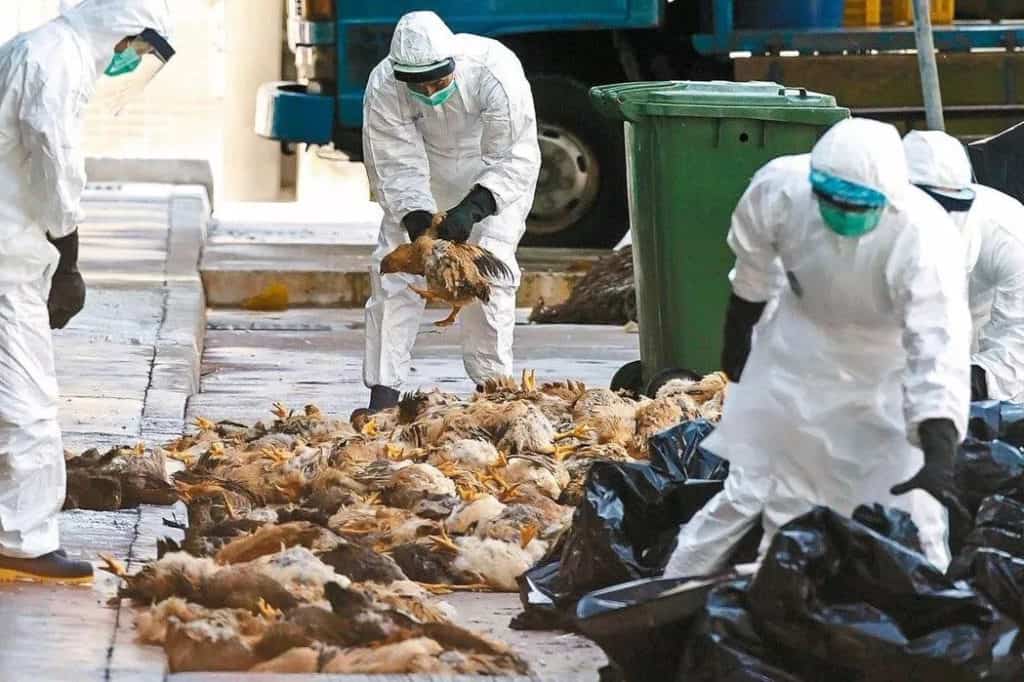
Sorry, no artificial intelligence here. AI, in this context, refers to Avian Influenza, a common avian disease you should look out for.
Avian Influenza is a respiratory illness found in birds. According to the USDA’s Animal and Plant Health Inspection Service, Avian Influenza, or AI, “is caused by an influenza type A virus.” The APHIS outlines the two different strains of AI: Highly pathogenic avian influenza (HPAI) and Low pathogenicity avian influenza (LPAI.).
The highly pathogenic strains are the ones that poultry owners should be concerned about it. The APHIS states that these “varieties are extremely potent, often fatal to domestic poultry, and can spread rapidly from flock to flock.”
The Indiana State Poultry Association warns that this disease is so powerful that “One gram (approximately one-fourth of a sugar packet) of compromized manure can contain more than enough virus to infect 1 million birds.”
Contraction Of Avian Influenza
AI is most commonly spread directly from bird to bird. This happens through secretions of the respiratory system and via manure. The disease can also be contracted and spread when chickens come into contact with wild birds and other fowl that carry the disease.
Another contraction method is from contaminated equipment, vehicles, clothing, and shoes. Smuggling and illegal movement of some chicken breeds may also encourage the spreading of Avian Influenza.
Symptoms Of Avian Influenza
Some of the most common signs of AI include lethargy, trouble walking, lack of appetite, diarrhea, lower rates of egg-laying, soft eggshells or misshapen eggs, discharge from the nose, coughing, and sneezing.
Chickens with AI may also have swollen heads, eyes, combs and wattles, and legs. There may also be discoloration in the wattles, combs, and legs. Birds with AI may sometimes experience sudden death for no obvious visible reason.
Treatment For Avian Influenza
Prevention of Avian Influenza is the best cure. To prevent AI, and other chicken diseases, biosecurity, and rigid sanitation practices should be in place.
Sanitation Tips For Avian Influenza:
- Prevent contact with wild birds
- Keep rodents away from your flock
- Wash hands before caring for chickens
- Disinfect shoes in footbaths
- Don’t visit other farms or homes with birds
- Temporarily isolate new birds
- Restrict visitors to your farm
Treating AI is a little more tricky than with some chicken diseases. According to the Merck Veterinary Manual, “Antigenically matched and properly administered vaccines can prevent clinical signs and death and greatly reduce virus replication.”
However, as there are many different subtypes of the virus, it is important to use the appropriate vaccine for the strain in question.
The Merck Manual also states that in some cases, broad-spectrum antibiotics may “control secondary pathogens and increasing home temperatures may reduce morbidity and mortality.
4. Infectious Coryza
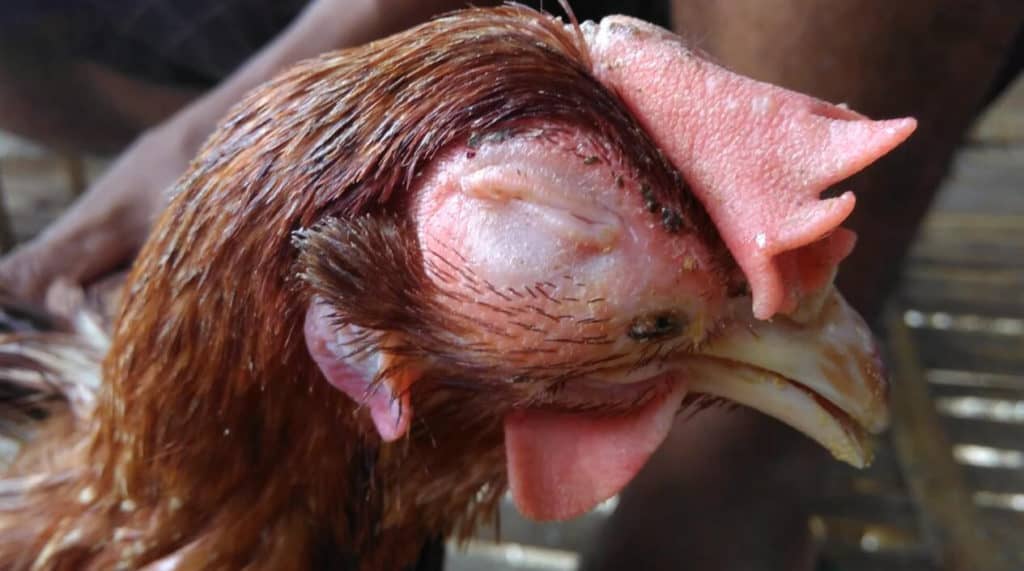
Merck Veterinary Manual defines Infectious Coryza as “an acute respiratory infection of chickens characterized by sneezing, nasal discharge, and swelling of the face; especially under the eyes.”
Infectious Coryza, also known as chicken croup or chicken cold, is caused by the bacteria Haemophilus paragallinarum. The Poultry Site further states that the condition is more commonly contracted in flocks that are held on multi-age farms and that never see complete depopulation.
Contraction Of Infectious Coryza
You know what they say – prevention is key. Well, with Infectious Coryza, it couldn’t ring truer. To start off, keep an eye out for those symptoms we talked about earlier – inflammation, runny eggs, yucky stuff coming from their face and/or nostrils; the not-fun list goes on.
If you spot even one of these things, check every single bird, just to be safe. And hey, if anyone comes down with the sniffles or fever, go ahead and count them all as exposed anyway. Again, prevention is the key.
Symptoms Of Infectious Coryza
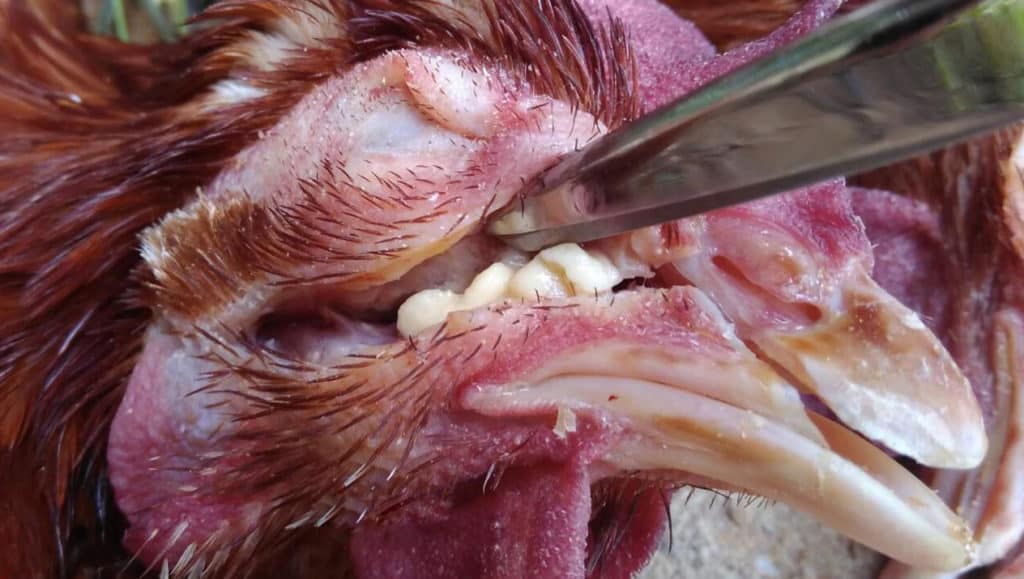
If you notice your chickens looking unwell, there could be something wrong with their health, like infectious coryza. Some common signs to keep your eye peeled for include swollen faces (including the wattles), drippy eyes or noses, laziness, loss of appetite, and difficulty in breathing.
But here’s the catch – similar symptoms might pop up for totally different issues. So whenever you suspect sickness among your birds, it’s important to observe other indicators before taking action. Oh, and by the way? Don’t forget that overall health and well-being impact egg production too!
Treatment For Infectious Coryza
Antibiotics, through water or feed, are crucial to treating birds that have already contracted Infectious Coryza. Erythromycin and oxytetracycline are two such drugs that have generally helped with this condition.
Newer drugs, such as fluoroquinolones and macrolides, seem to show promise, as do medicines like sulfonamides and sulfonamide-trimethoprim combos.
As with the aforementioned chicken diseases, an drop of prevention is worth a gallon of cures. Keep your farm sanitized and consider complete depopulation versus continuously rotating various ages of birds. For tips on cleaning the manure from your coops, check out Farm Alarm’s video tutorial.
Summary
In summation, Coccidiosis, Fowl Cholera, Avian Influenza, and Infectious Coryza are very common diseases among poultry. Since there is a high likelihood of at least one of these chicken diseases afflicting your flock at some stage, it is wise to remember the symptoms so that you can treat your birds, or seek treatment for them, as soon as you notice a problem.

Joseph Hudson has been raising chickens for over 15 years. In 2018, he completed the Agriculture & Natural Resources program at Mt. San Antonio College. He currently raises over 1400 chickens on his 7.5-hectare farm. He keeps sharing his experience on raising healthy and happy chickens on Chicken Scratch The Foundry.

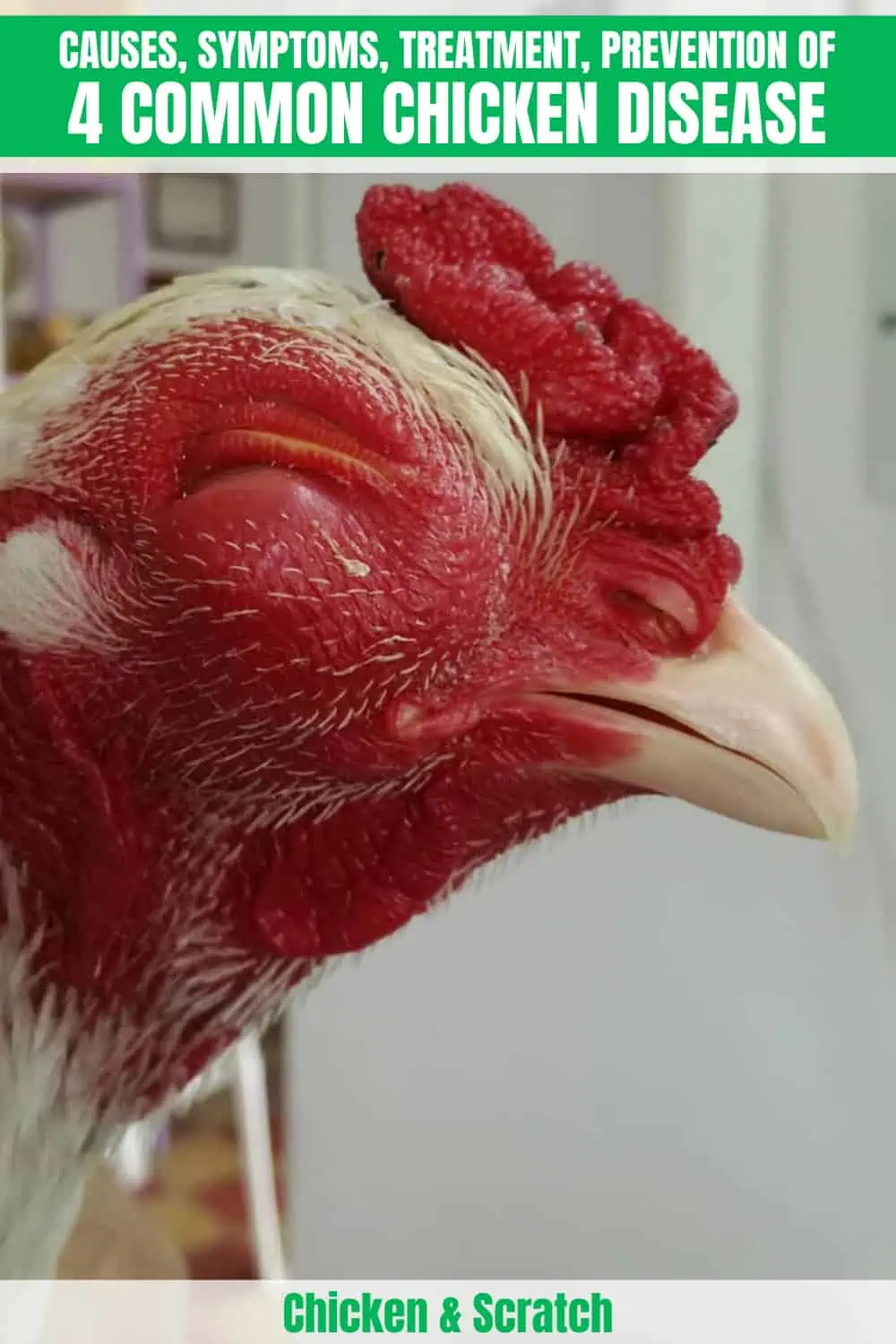







Very important and handy information; typically researched to suit amateur and established poultry farmers.
Thanks for this information. I will use it to achieve good results in my poultry as iam just starting.
Woo what a lecture! These are the diseases my birds were encountering, l was in the dark, thanks a lot
Thanks for your lecture
Awesome thanks for best information -& lecture
Thanks for such a crucial information
Thank you so much for such a lovely article with informative content. Hope to see more of a similar article.
Best information
Sure and perfect information
Thanks for the info
Love this info very, very helpful .
Some of drugs that are commonly used to treat
Thanks you for the informative lecture on how to treat & care for infectious poultry birds.
You’re welcome! I’m glad to hear that you found the article on common chicken diseases informative and useful.
Can you advise what to do when there is no vet or meds.
My hen who wasn’t laying for over two weeks has been ailing sometimes I think she is dead then she perks up I try to finger her water the.nI thought to moisten her comb as she refuses everything now including water… she is getting thinner and weaker and has to be propped upright
I could send a picture of her
I’m sorry to hear about your chicken. It sounds like she’s in a poor state. While I can’t replace a vet’s advice, I’ll do my best to give you some basic guidelines. However, please bear in mind that it’s crucial to consult with a vet or an expert if at all possible, especially in severe cases.
1. Keep trying to hydrate her. If she’s refusing water, you might try using a dropper to gently drop some water into her beak. Be careful not to cause choking. For nutrition, consider moistening her feed with water or making a mash with it, which can be easier for her to eat. You can also try giving her soft foods like scrambled eggs or cooked rice.
2. If you have other chickens, separate her from them to prevent possible spread of disease and also to avoid bullying which can happen if a chicken appears weak. The isolation will give her a quiet and stress-free place to recover.
3. Sick chickens often struggle to regulate their body temperature. Make sure she’s in a warm place, but also make sure she can move to a cooler spot if she gets too warm.
4. Take a look for any signs of injury, swelling, or parasites. Check her vent to see if it’s clean and free of obstruction. If you notice anything unusual, this can provide clues to what might be wrong.
5. Some natural remedies can help boost a chicken’s immune system and support her health. Adding apple cider vinegar (1 tablespoon per gallon of water) or crushed garlic to her water can provide a boost. Remember these are not cures, but supportive measures.
Remember that if her condition continues to worsen or doesn’t improve, professional veterinary help is necessary if it’s an option. This advice is not exhaustive or professional medical advice, so it’s crucial to consult with a professional if you can.
Hello, please help me, I am losing many valuable chickens ! The are fine then they are on the floor! Flopping around, they can’t stand up their head kinda turns crazy they poop yellow! This last for 3 to 4 days then they die! Please what can it be and a cure! Thank you so much!
Oh no, I’m sorry to hear about your chickens. Based on what you described, it sounds like they might have Newcastle Disease. The symptoms match: the twisted head, weakness, and yellow poop.
There’s no specific cure, but supportive care can help. Most importantly, consult a vet for a proper diagnosis. In the future, consider vaccinating against this disease and always maintain clean surroundings for your birds. Hope your chickens get better soon! 🐔❤️